The Publication Library contains guidance and policy papers, reports, strategies, program regulations, guidelines, brochures and more.
To search the DHS Publications Library, please enter search terms below.
-
S&T OUP Student Resources Fact Sheet
The Department of Homeland Security (DHS) Science and Technology Directorate (S&T) Office of University Programs (OUP) offers postsecondary institutional grants, internships and summer research experiences to build a diverse, highly capable, technical workforce for the homeland security enterprise.
-
Department of Homeland Security's Strategic Plan for Fiscal Years 2020-2024
The DHS Strategic Plan for Fiscal Years 2020-2024 articulates the Department’s missions and goals, the strategies we employ to achieve each goal, and long-term performance measures that we use to evaluate our progress.
-
DHS/CBP/PIA-046 Border Patrol Enforcement Tracking System (BPETS/BPETS2)
The Border Patrol Enforcement Tracking System (BPETS) is a Department of Homeland Security (DHS) U.S. Customs and Border Protection (CBP) U.S. Border Patrol (USBP) web-based application that allows USBP to analyze incident data and manage the deployment of personnel and resources. BPETS is a legacy system, once maintained by the Department of Justice (DOJ) Immigration and Naturalization Service (INS), and is now maintained by CBP. The BPETS2 system is an enhancement to the legacy BPETS system, which adds advanced technologies and improved system integration. Currently, BPETS and BPETS2 operate in conjunction with one another, but the BPETS2 system will eventually replace the legacy BPETS system. CBP is conducting this Privacy Impact Assessment (PIA) because BPETS and BPETS2 both collect, maintain, and disseminate personally identifiable information (PII).
SORNs:
- OPM/GOVT-1 General Personnel Records
- OPM/GOVT-10 Employee Medical File System Records
- DHS/ALL-019 Payroll, Personnel, and Time and Attendance Records System of Records
- DHS/CBP-023 Border Patrol Enforcement Records (BPER)
- DHS/ALL-014 Personnel Emergency Contact Information System of Records
-
DHS/ICE/PIA-051 Law Enforcement Information Sharing Service (LEIS Service)
The Department of Homeland Security (DHS) U.S. Immigration and Customs Enforcement (ICE) owns and operates the Law Enforcement Information Sharing Service (LEIS Service or Service). The LEIS Service enables domestic law enforcement agencies outside of DHS to query certain information contained in DHS systems, and also permits authorized DHS law enforcement officials and analysts to query data from other law enforcement entities that have signed agreements with DHS to use the Service. All entities querying the LEIS Service must have a signed agreement. The LEIS Service is a non-public facing web service that functions as a back-end super highway data sharing system. The LEIS Service was previously described in a Privacy Impact Assessment (PIA) update published in 2011 under the ICE Pattern Analysis and Information Collection (ICEPIC) system. In 2012, ICEPIC was replaced by the DHS Pattern and Information Collaboration Sharing System (DPICS2), which was subsequently retired in 2014. Since that time, the LEIS Service has been operating independently. ICE is issuing this PIA to discuss the privacy risks and mitigations with collecting, using, disseminating, and storing information related to the LEIS Service. Once this PIA is issued, the previous PIA will be retired.
-
PCR of the S & T Directorate
The DHS Privacy Office launched a Privacy Compliance Review (PCR) on July 27, 2018, under the Chief Privacy Officer’s authority in accordance with Section 222 of the Homeland Security Act of 2002, as a result of growing concerns that the DHS Science and Technology Directorate’s (S&T) privacy compliance process, particularly for those programs involving social media and volunteers, did not meet requirements under DHS policies. The PCR reviewed DHS S&T’s privacy compliance and privacy practices from October 1, 2016, through July 28, 2018.
-
S&T AgConnect Fact Sheet
Developed by the Department of Homeland Security (DHS) Science and Technology (S&T) Directorate Center of Excellence for Zoonotic and Animal Disease Defense at Texas A&M University, AgConnect® is a suite of data integration and analysis products designed to enhance situational awareness during infectious animal disease outbreaks.
-
S&T CRISTAL Fact Sheet
To help mitigate the interruption of lifeline supply chains, researchers at a Department of Homeland Security Science and Technology Directorate Center of Excellence, the Food Protection and Defense Institute (FPDI), are developing new ways of identifying and understanding how and where supply chains are vulnerable to disruptions. As part of this work, research teams are also finding methods to document and assess the components of food supply chains – something that could also help meet goals of the Food Safety Modernization Act.
FPDI has developed an early prototype software tool for supply chain mapping, vulnerability assessments and analysis called Criticality Spatial Analysis (CRISTAL). Through CRISTAL, FPDI aims to develop a new capability to: (1) define and document food critical infrastructure, and (2) assess risk in the global food supply chain.
-
S&T COAST Fact Sheet
Researchers from the Center for Visual and Data Analytics (CVADA), a Department of Homeland Security (DHS) Science and Technology (S&T) Center of Excellence, have worked with the United States Coast Guard (USCG) to develop the Coastal Operations Analysis Suite of Tools (COAST) that meets a broad set of USCG mission requirements. This suite of tools includes visualization, simulation, math modeling, and optimization techniques.
-
S&T MCAP Fact Sheet
In an emergency, it is vital that first responders are able to communicate and share information, regardless of the agency they represent. Yet, interoperability and information integration remain a challenge when it comes to real-time, multi-agency coordination.
To address this challenge, the Center for Visualization and Data Analytics (CVADA) at Rutgers, the State University of New Jersey, a Department of Homeland Security (DHS) Science and Technology (S&T) Center of Excellence, developed the Mobile Computing Application Platform (MCAP) in partnership with the U.S. Army Tank Automotive Research, Development and Engineering Center.
-
S&T Predicting Crowd Behavior Fact Sheet and Video
The Port Authority of New York and New Jersey (PANYNJ) is tapping a high-tech approach developed by the DHS S&T Center for Visualization and Data Analytics (CVADA) at Rutgers to enable safer crowd movement during emergencies and other events. The CVADA-Rutgers research team uses a combination of mathematical modeling and LiDAR (light and radar) to determine the best way to manage rush-hour crowds and bus schedules—including emergency evacuations— before, during, and after PANYNJ’s major reconstruction and rehabilitation construction projects.




